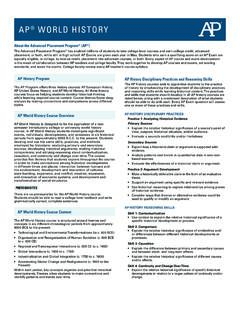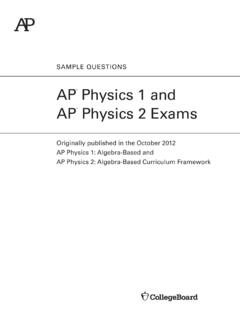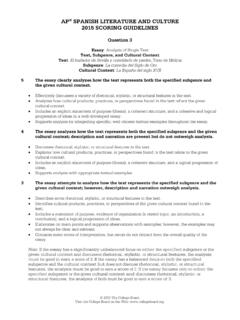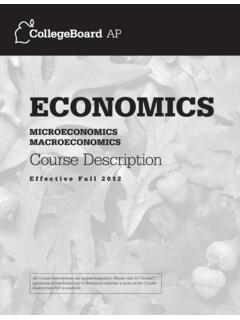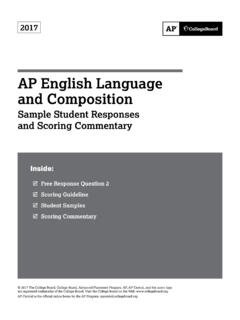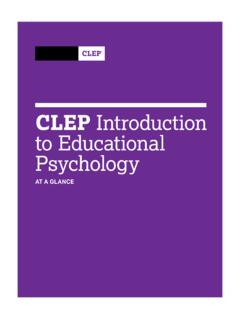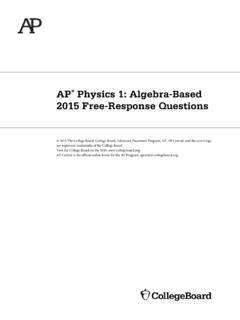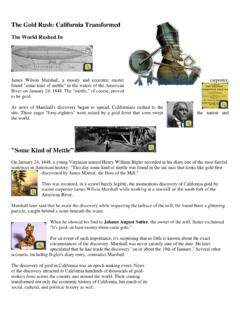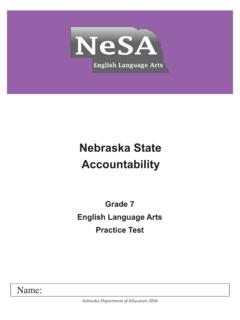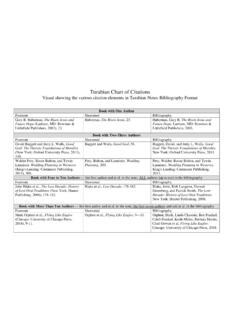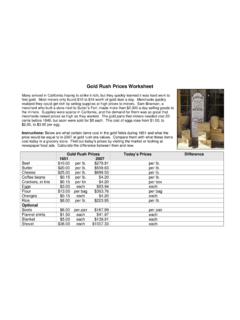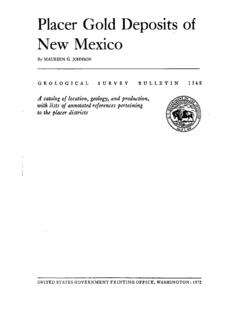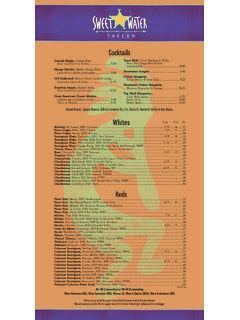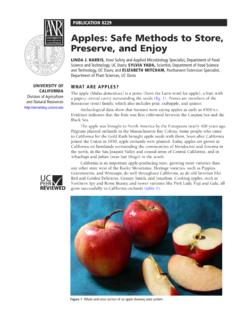Transcription of AP UNITED STATES HISTORY 2015 SCORING GUIDELINES
1 AP UNITED STATES HISTORY 2015 SCORING GUIDELINES 2015 The College Board. Visit the College Board on the Web: Question 3 Evaluate the extent to which the Mexican-American War (1846 1848) marked a turning point in the debate over slavery in the UNITED STATES , analyzing what changed and what stayed the same from the period before the war to the period after it. A. Thesis: 0 1 point Skills assessed: Argumentation + Periodization STATES a thesis that directly addresses all parts of the question. The thesis must do more than restate the question. 1 point Does not state a thesis that directly addresses all parts of the question or has a thesis that merely restates the question. 0 points Response is completely blank. B. Support for argument: 0 2 points Skills assessed: Argumentation + Use of Evidence Supports the stated thesis (or makes a relevant argument) using specific evidence.
2 1 point OR Supports the stated thesis (or makes a relevant argument) using specific evidence, clearly and consistently stating how the evidence supports the thesis or argument, and establishing clear linkages between the evidence and the thesis or argument. 2 points Response does not use specific evidence to support the stated thesis or a relevant argument. 0 points Response is completely blank. C. Application of targeted historical thinking skill: 0 2 points Skill assessed: Periodization PERIODIZATION Describes the ways in which the historical development specified in the prompt was different from OR similar to developments that preceded and/or followed. 1 point OR Analyzes the extent to which the historical development specified in the prompt was different from AND similar to developments that preceded and/or followed, providing specific examples to illustrate the analysis.
3 2 points Response does not describe the ways in which the historical development specified in the prompt was different from OR similar to developments that preceded and/or followed. 0 points Response is completely blank. AP UNITED STATES HISTORY 2015 SCORING GUIDELINES 2015 The College Board. Visit the College Board on the Web: Question 3 (continued) D. Synthesis: 0 1 point Skill assessed: Synthesis Response synthesizes the argument, evidence, and context into a coherent and persuasive essay by accomplishing one or more of the following as relevant to the question. Appropriately extends or modifies the stated thesis or argument. 1 point OR Explicitly employs an additional appropriate category of analysis ( , political, economic, social, cultural, geographic, race, gender) beyond that called for in the prompt. 1 point OR Appropriately connects the topic of the question to other historical periods, geographical areas, contexts, or circumstances.
4 1 point Response does not synthesize the argument, evidence, and context into a coherent and persuasive essay. 0 points Response is completely blank. AP UNITED STATES HISTORY 2015 SCORING GUIDELINES 2015 The College Board. Visit the College Board on the Web: Question 3 (continued) SCORING NOTES Responses define the chronological beginning and end points for the essay; the focus of the response helps determine what information is considered appropriate. Thesis An acceptable thesis would evaluate the extent to which the Mexican-American War was a turning point, indicating the extent of change OR continuity. Note: Indicating explicitly the extent of change implies the extent of continuity, and vice versa. Possible thesis statements emphasizing change could include the following: The Mexican-American War marked a turning point in the debate over slavery in the by unleashing a massive tension between the North and South on what land would be free and what land would be slave.
5 The Mexican-American War marked a huge turning point in the debate over slavery because it brought to light the controversy of territorial self-determination and asked the question that would define America on a fundamental level: is this country one of slavery or one of freedom? Possible thesis statements emphasizing continuity could include the following: The questions of slavery and expansion were inevitable political issues. The culmination of Manifest Destiny only sped up the process. Possible thesis statements modifying the position could include the following: The Compromise of 1850 with its controversial points, not the Mexican-American War, was the major turning point of 19th century. Support for Argument Possible evidence that could be used includes the following: BEFORE Mexican-American War Manifest Destiny Missouri Compromise (1820) Increasing fear of slave power William Lloyd Garrison, The Liberator (1830) Gag rule Frederick Douglass Annexation of Texas (1845) Mexican-American War and AFTER Opposition to Mexican-American War among northern Whigs Abraham Lincoln Spot Resolutions (1846) Wilmot Proviso (1846) Popular sovereignty Stephen A.
6 Douglas Compromise of 1850 o california enters as free state o Stricter fugitive slave law o Popular sovereignty in Utah and New Mexico Territory o Slave trade banned in Washington, Kansas-Nebraska Act (1854) Formation of Republican Party (1854) Bleeding Kansas (1855) Dred Scott v. Sandford (1857) AP UNITED STATES HISTORY 2015 SCORING GUIDELINES 2015 The College Board. Visit the College Board on the Web: Question 3 (continued) Application of Historical Thinking Skills Essays earn 1 point by describing the ways in which the debates over slavery were different from OR similar to debates over slavery that preceded and/or followed the Mexican-American War. Essays earn 2 points by analyzing the ways in which the debates over slavery were different from AND similar to debates over slavery that preceded and/or followed the Mexican-American War, providing specific examples to illustrate the analysis.
7 Examples of issues that influenced the debate over slavery could include the following: o Discussion of political balance based on slavery before and after the war o Discussion of extent of cotton cultivation before and after the war o Discussion of the abolition movement before and after the war o Discussion of the ideologies of free soil and free labor before and after the war Synthesis Responses can earn the synthesis point by crafting a persuasive and coherent essay. This could be accomplished by but not limited to the following: Providing a conclusion that extends or modifies the analysis in the essay by explicitly assessing the impact of the Mexican-American War on American Indian and/or Hispanic people living in the territory transferred from Mexico to the UNITED STATES . Introducing another category of historical analysis by explicitly calling out the cultural or gender, or racial elements of a political story.
8 Making a connection to another historical period or context. Examples could include the following: o Concretely and explicitly linking the Mexican-American War to earlier imperial conflicts such as the Seven Years War and the American Revolution o Explicitly linking the Mexican-American War to subsequent developments such as the Civil War and Reconstruction or the 20th century Civil Rights movement 2015 The College the College Board on the Web: 2015 The College the College Board on the Web: 2015 The College the College Board on the Web: 2015 The College the College Board on the Web: 2015 The College the College Board on the Web: 2015 The College the College Board on the Web: UNITED STATES HISTORY 2015 SCORING COMMENTARY 2015 The College Board. Visit the College Board on the Web: Question 3 Long Essay Overview Long Essay Question 3 allowed students to evaluate the extent to which the Mexican-American War marked a turning point in the debate over slavery in the , analyzing what changed and what stayed the same from the period before the war to the period after.
9 The question assessed the historical thinking skill of periodization and covered Period 5, which ranges from 1844 to 1877. Sample: 3A Score Thesis: 1 This essay has a thesis that is most clearly stated in the conclusion, namely that the war was a huge turning point due to the increased tensions that arose out of the newly acquired land. Score Support for Argument: 2 This essay uses a significant amount of specific evidence effectively to support the thesis. It notes that the lands acquired from the war posed a particular problem because their slave status could not be determined through the Missouri Compromise, thus giving rise to proposals such as the Wilmot Proviso and popular sovereignty, which ultimately led to the Compromise of 1850. The essay also notes that other tensions (labor systems, abolitionism, etc.) were inflamed by the war. Score Application of Targeted Historical Thinking Skill: 2 This essay analyzes both similarities and differences, although the discussion of popular sovereignty notes a difference that is more subtle than the similarities such as racist oppression, labor systems, and the sectional divide that the essay examines.
10 Score Synthesis: 1 This essay s synthesis lies in its examination of the long-term roots of the crisis, arising from the Declaration of Independence and the Louisiana Purchase (and by noting that the new problems were not resolvable using earlier solutions). Sample: 3B Score Thesis: 0 This essay s thesis lacks the evaluative element required in the prompt and merely notes that the war amounted to a turning point with the expansion of Texas and a rush of Republicans to annex a new state on their side. Score Support for Argument: 1 This essay uses migrations into Texas and california as examples of expansion, though it mostly restates the thesis, rather than using the evidence to support the argument. Score Application of Targeted Historical Thinking Skill: 1 This essay points to westward migration as the basis for the application of periodization: expansion into Texas prior to the war and into california after the war, although it notes no differences.
